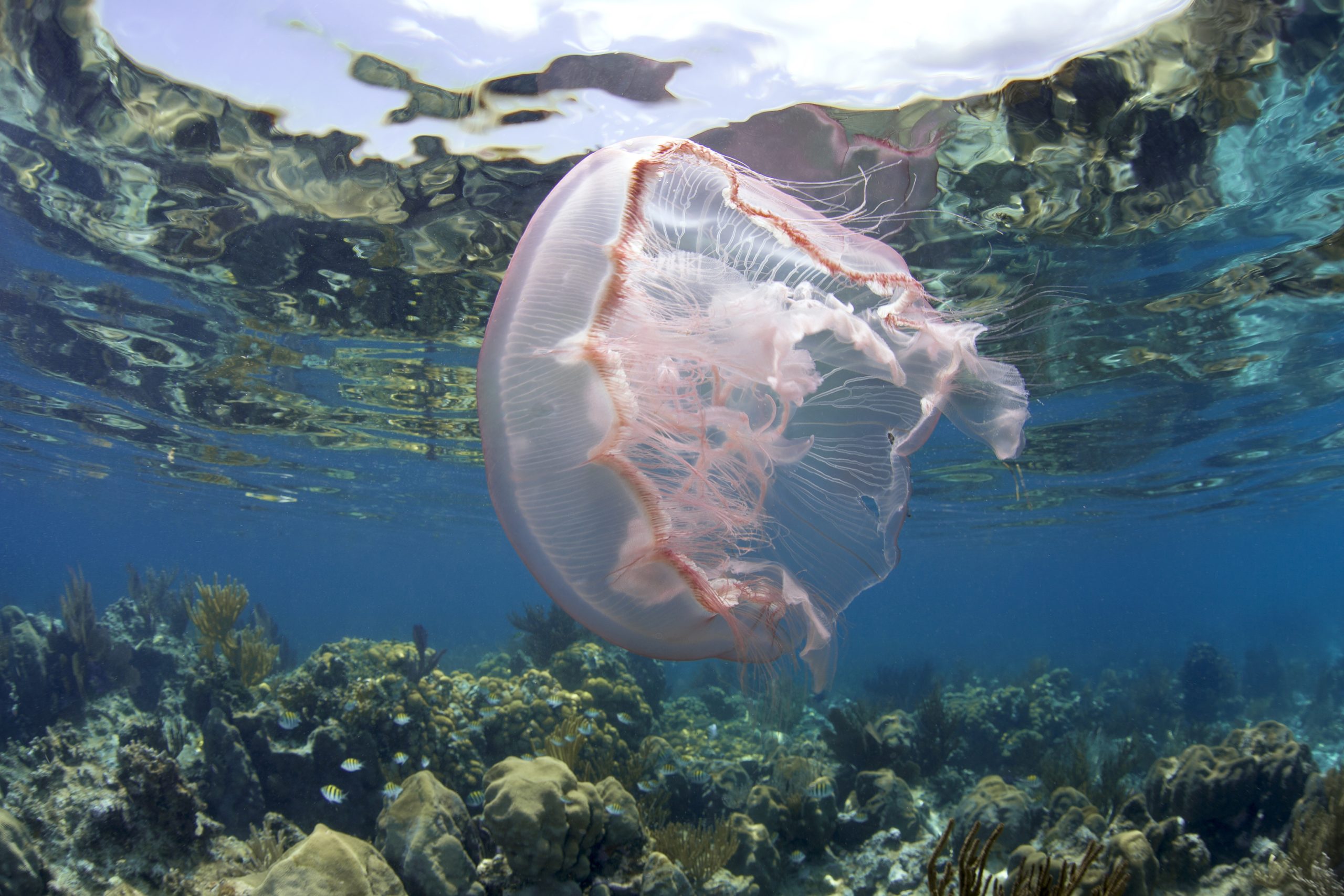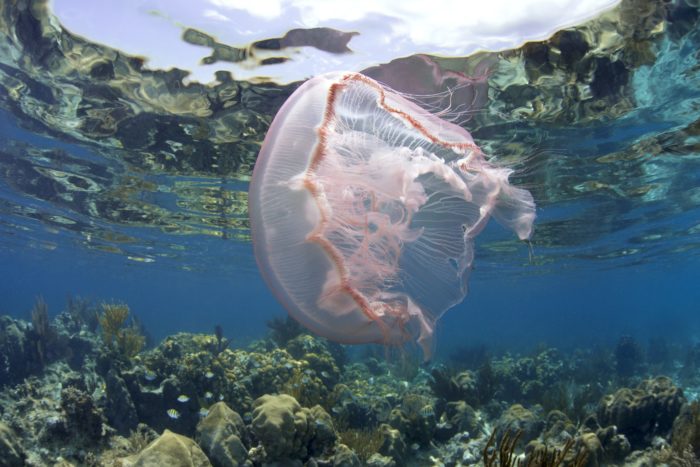
Sea Wonder: Moon Jelly

Photo credit: Katy Danca Galli
Moon jelly is one of the common names for animals in the genus Aurelia, a classification of invertebrates you might also know as jellyfish and may have seen or touched on your last aquarium visit. They are also called the common jellyfish, moon jellyfish, or saucer jelly. No matter what you call them, these simple, brainless organisms are pretty complex and interesting—and tell us a lot about the health of marine ecosystems.
Appearance
Moon jellies are gelatinous and completely transparent all around, with a blue-grey disk at the center of their bell. Since their bodies are made of more than 90 percent water, their simplistic set of organs are visible to us, including four bright, horseshoe-shaped gonads, noodle-like oral arms that move food to the mouth, tiny tentacles all the way around the bell, translucent stomach folds, and gastrovascular canals that look like veins you would see in a leaf. Some of the largest moon jellies can reach a diameter of nearly 12 inches, or the size of a normal dinner plate and they are nearly weightless.
Diet and Habitat
Moon jellies often live near coastlines in the Atlantic, Pacific, and Indian oceans, as well as nutrient-rich offshore upwelling areas populated by their prey. They aren’t strong swimmers and can’t resist currents, so they have no choice but to go where the ocean takes them, which can include stranded on beaches or stuck in rocky intertidal zones, especially after storms or strong tides. These organisms can live in saltwater or brackish (mixed salt- and freshwater) environments, and waters between 45- and 70-degrees Fahrenheit offer them the best chance of survival. This means that moon jellies can be found in most of our country’s national marine sanctuaries, with the exception of Mallows Bay-Potomac and Thunder Bay.
Moon jellies are carnivorous, feeding on zooplankton like crustacean larvae, protozoans, and rotifers. Since they can’t pursue prey by swimming, moon jellies are passive, opportunistic feeders, meaning they consume anything that they can catch. They hunt by stinging prey with cells called nematocysts that are located on the short tentacles that surround their bell, and then they collect stunned prey on their oral arms that are covered in mucus. Trapped food then moves to the mouth followed by one of eight branched canals that lead to the stomach at the center of the bell. When food is scarce and feeding opportunities are few and far between, moon jellies will shrink their bodies to merely ten percent of their original size to conserve energy, returning to normal when food is plentiful again.
When it comes to predators, moon jellies have many—they are pretty low on the food chain. Seabirds, sea turtles, marine mammals, and fish like the ocean sunfish all rely on moon jellies for at least part of their diet. Unfortunately, floating ocean plastic bags can look just like moon jellies to their predators and are often eaten as a result.
Life History
Moon jellies are prehistoric animals, meaning they have survived life on earth for millions of years. Like all other cnidarians (the phylum of animals that includes jellyfish, sponges, corals, and other simple marine invertebrates), jellyfish begin their lives as microscopic larvae that hatch from eggs fertilized in the water column.
Larvae float along with the ocean currents until they settle on the ocean floor— or fixed features like rocks or seagrass — where they become polyps that have long tentacles for feeding. After a few weeks to months, the jelly polyps lose their tentacles, separate into multiple segments, and become strobila, which is a sort of home base for soon-to-be juvenile jellies. During a phase called strobilation, the top segment of the strobila breaks off and turns into an ephyra, which look like tinier, less developed moon jellies, and the strobila will continue releasing genetic clones of these ephyra into the water column until only the original polyp is left. Ephyrae continue growing until they reach their full size as adult moon jellies, where they reproduce in the spring and summer months and continue the jellyfish life cycle. Moon jellies generally only live for a year or two, but polyps can live, feeding and producing genetic clones for up to 25 years!
Since moon jellies lack respiratory, circulatory, and nervous systems, they don’t have complex social structures, though they can be found floating along in large groups called blooms. These animals, while simple, are important parts of marine food webs, transforming organic matter and keeping plankton communities in balance.
Threats and Conservation
Moon jellies are not threatened or endangered but can serve as an indicator of marine ecosystems out of balance. Unlike other larger species (especially moon jelly predators), they can survive and thrive in otherwise uninhabitable waters. This means that as ocean health declines, moon jelly populations can actually increase. This is true in environments and ecosystems that experience human-induced phenomenon like overfishing, ocean warming, ocean acidification, and pollution.
While they are beautiful and mesmerizing, populations that are too large and out of balance tell us something is wrong. We can all help keep moon jelly populations under control (and our ocean healthy!) by choosing sustainably sourced seafood, reducing our energy consumption, and encouraging our elected officials to support policies that address ocean acidification, ocean warming, and species protection.
